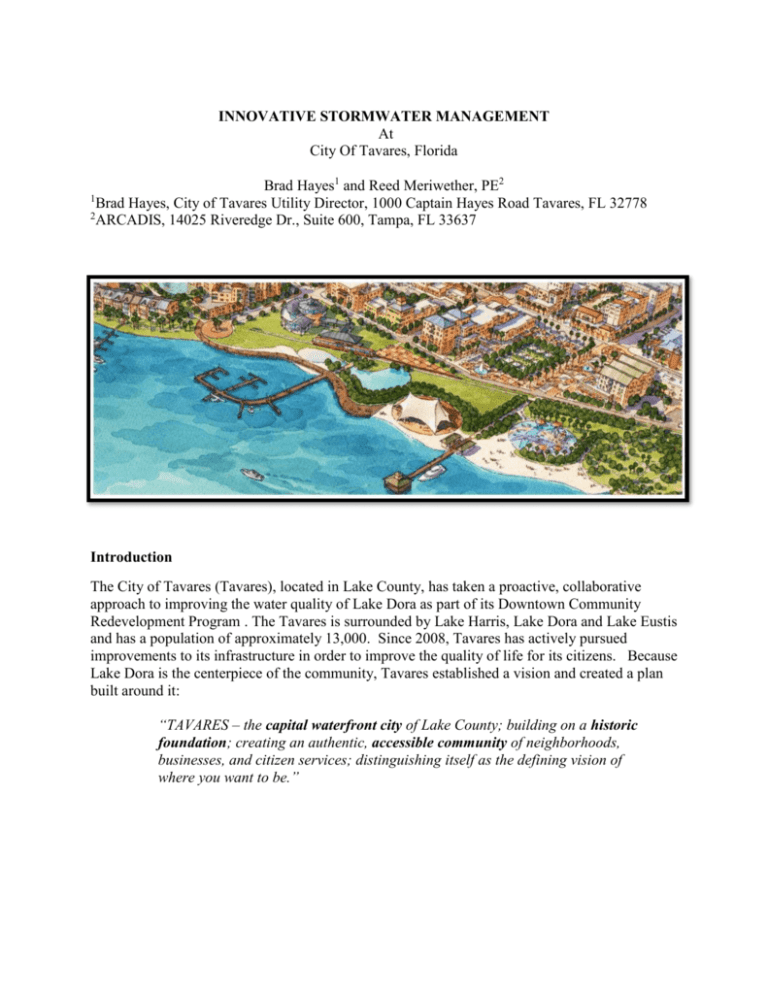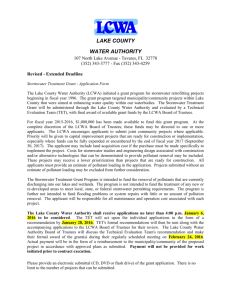Memo
advertisement

INNOVATIVE STORMWATER MANAGEMENT At City Of Tavares, Florida Brad Hayes1 and Reed Meriwether, PE2 1 Brad Hayes, City of Tavares Utility Director, 1000 Captain Hayes Road Tavares, FL 32778 2 ARCADIS, 14025 Riveredge Dr., Suite 600, Tampa, FL 33637 Introduction The City of Tavares (Tavares), located in Lake County, has taken a proactive, collaborative approach to improving the water quality of Lake Dora as part of its Downtown Community Redevelopment Program . The Tavares is surrounded by Lake Harris, Lake Dora and Lake Eustis and has a population of approximately 13,000. Since 2008, Tavares has actively pursued improvements to its infrastructure in order to improve the quality of life for its citizens. Because Lake Dora is the centerpiece of the community, Tavares established a vision and created a plan built around it: “TAVARES – the capital waterfront city of Lake County; building on a historic foundation; creating an authentic, accessible community of neighborhoods, businesses, and citizen services; distinguishing itself as the defining vision of where you want to be.” The Lake Front Improvement Plan Tavares has invested heavily in the 6-acre Wooten Park, which includes: • Seaplane Basin and Marina • 36 boat slips/ 4 seaplane moorings marina and aviation fuel station • Tavares to Mt. Dora Water Taxi service • Tav-Lee Trailhead (10 mile shared-use trail from Tavares to Leesburg) • Children’s spray Park • Performance areas, sandy beach, lighted pier • Canoe/kayak rentals Tavares has also invested in the Pavilion on the Lake: • 8,000 square foot facility positioned over Lake Dora • Two (2) ballrooms • Meeting rooms with capacity for 500 persons In collaboration with the community, Tavares created a master plan for economic development in the Downtown Community Redevelopment Area (CRA). The plan is designed to improve the infrastructure of air, water and rail transportation assets to support new retail space, arts and entertainment venues, and community events that attract residents, visitors and businesses alike. The plan is designed to entice businesses, residents, and visitors into the heart of Tavares, attracted by retail, the arts, and festivals, and brought to us through improved infrastructure for air, water, and rail transport. The following improvements were proposed as part of the CRA plan: • • • • Wastewater collection system improvements – replacement of 54,950 linear feet of gravity sewer and force mains Potable water system improvements – replacement of approximately 77,450 linear feet of existing water main Stormwater system improvements – construction of more than 8,000 linear feet of new collection system in two (2) phases and new treatment wetland Roadway improvements – construction of 60,000 linear feet of roadway Funding the Plan Tavares’ CRA abuts Lake Dora to the south. Lake Dora is considered part of the Upper Oklawaha River Basin. Lake Dora has been established as impaired and the Florida Department of Environmental Protection (FDEP) has established Total Maximum Daily Loads (TMDL) for total phosphorus. Lake Dora is the focal point of the City’s downtown redevelopment plan with the expansion of parks, trails, businesses and other mixed use activities along the water front. It is vital to the CRA plan that the water quality of Lake Dora be improved. City Planners knew that with all the proposed improvements, additional impervious cover would be created. A region approach was considered more cost effective than individual efforts to mitigate stormwater impacts. The City decided to incorporate improvements to the quality of Lake Dora into the plan to improve the quality of life for its citizens. The goals included: • • • • • Reduce nutrient loading to Lake Dora. Reduce total suspended solids loading to Lake Dora. Use a stainable treatment approach. Provide public education on stormwater pollution issues. Enhance the quality of life, community vibrancy, and economic development in the City of Tavares. Through a collaborative effort with City Planners, ARCADIS developed a comprehensive plan to redirect stormwater away from Lake Dora toward a multi-cell stormwater treatment wetland. The stormwater design was done in concert with other major improvements to streets and drainage, water mains and sanitary sewers. The treatment wetland is designed to reduce the discharges of total phosphorus, total nitrogen and total suspended solids into Lake Dora and contribute in the reduction of Lake Dora TMDLs. This load reduction will help maintain designated uses established by FDEP for recreation, as well as for the propagation and maintenance of a healthy, well-balanced population of fish and wildlife. This is key to the economic success of the City of Tavares’ Downtown Community Redevelopment Plan. Since many of the regulating agencies also provide funding for various water quality improvement projects, it was crucial to sell the agencies on the fact that that the CRA plan would benefit Lake Dora as much as it benefits Tavares. The strategy was very successful. The City was able to secure over $6 million in grant funding from various agencies in water quality related grants including FDEP, TMDL legislative appropriations, 319 grant, St. John’s River Water Management District (SJRWMD), Community Budget Issue Request (CIBR), and Lake County Water Authority (LCWA). Now the regulators are also invested in the success of the project. This grant money, combined with low interest State Revolving Fund (SRF) loans, means the City of Tavares is well on the way to seeing its vision become a reality. Stormwater Improvements To improve the water quality in Lake Dora, the first phase of the stormwater improvements include a stormwater interceptor to divert the first 1-inch of stormwater from seven existing Lake Dora outfalls into a wet detention pond. The project will contribute to the reduction of the FDEP implemented TMDL for total phosphorus (TP), as well as total nitrogen (TN), and total suspended solids (TSS). The project will also be used to inform and educate the public about stormwater pollution issues. Phase 1 includes the construction of the following facilities: • 8.5 acre stormwater treatment pond • 3,400 linear feet of reinforced concrete pipe ranging from 15-inch to 36-inch pipe • The elimination of four (4) out of seven (7) outfalls into Lake Dora • The CRA drainage area encompasses nearly 400 areas of mixed-use commercial and residential • The system was modeled using Interconnected Channel and Pond Route (ICPR) Innovative Wet Pond Design The existing 8.5 acre wetland is a partially natural and manmade facility that has been in use as a stormwater detention pond since the 1960s. The existing system provides little treatment, is overgrown and is unmaintainable. Because it was left in an unmanaged state for so long, the USACE has designated the facility as natural wetlands. The proposed project would impact approximately 7.52 acres of the wetlands. Tavares plans to mitigate this loss through the preservation of approximately 172 acres of forested uplands it owns within the same Southern Ocklawaha River drainage basin. The proposed preservation area will be placed under a conservation easement to the SJRWMD. ARCADIS, in partnership with Griffey Engineering Inc., developed hybrid wetland systems with enhanced nutrient removal capabilities, stormwater detention and a park-like setting. Treatment wetland and ponds have become widely accepted as urban stormwater treatment devices over the past two decades and are increasingly being integrated into water sensitive urban design practices. This growing popularity has been largely due to the fact that wetland and pond based systems offer the advantages of providing a relatively passive, low-maintenance and operationally simple treatment solution while potentially enhancing habitat and aesthetic values within the urban landscape. The system incorporates a more recent development, managed aquatic plant systems (MAPS), which are floating treatment wetland and are an emerging variant of constructed wetland technology. MAPS consist of emergent wetland plants growing hydroponically on structures floating on the surface of a pond-like basin. They represent a means of potentially improving the treatment performance of conventional pond systems by integrating the beneficial aspects of emergent vegetation without being constrained by the requirement for shallow water depth. In MAPS, the plant stems remain above the water level, while their roots grow down through the buoyant structure and into the water column. In this way, the plants grow in a hydroponic manner, taking their nutrition directly from the water column in the absence of soil. Beneath the floating mat, a hanging network of roots, rhizomes and attached biofilms is formed. This hanging root-biofilm network provides a biologically active surface area for biochemical processes as well as physical processes such as filtering and entrapment. For Tavares, ARCADIS combined all three aspects into one designed system. The initial deep cell allows coarse sediment to collect. Deeper segments also combine aerobic, anoxic and anaerobic zones for variable treatment of organics and nutrients. As the water passes to the next cell, a cascade provides aeration. Emergent vegetation in the shallow zones provides a thick stem matrix for attached aerobic bacterial along with the natural uptake of nutrients from the plants. Fountains may be added to provide aeration and mixing while MAPS provide additional nutrient reduction. Walking paths traverse the entire system and offer an enjoyable nature botanical garden like experience. Water control structures allow for raised water levels and shortterm detention during storm events for permitted outfall control. The MAPS are aquatic plant-based BMPs, which remove nutrients through a variety of processes related to nutrient uptake, transformation, and microbial activities. Examples include planted littoral zones and floating wetland. They can be incorporated into a wet detention BMP treatment train to provide additional treatment and nutrient removal after the wet pond has provided reduction of pollutants through settling and other mechanisms. The FDEP established BPM reductions at 20 percent TP and 20 percent TN. One of the most common trade names for MAPS is Beemats. Combined Nutrient Removal The anticipated removal efficiencies for TP from the stormwater treatment pond are estimated at 61.5 percent using the SJRWMD Lake Apopka Hydrologic Basin Pollutant Loading Analysis. Removal efficiencies for TSS are estimated at 67 percent using the National Pollutant Discharge Elimination System (NPDES) description of wet ponds. In order to qualify for certain grant funding, a higher level of phosphorus removal is required. The final design includes a series of deep and shallow cells. This arrangement extends the littoral shelf areas in balance with deep open water sections. The open water sections are enhanced with the floating MAPS. In addition to plant uptakes, bacteria attach to the stem matrix to reduce organic compounds and uptake nitrogen. Anaerobic zones in the deep cells provide nitrification followed by shallow cells and denitrification. Shallow cells composed mostly of littoral zones increase soil contract with phosphorus for more uptake along with plants. The modeled uptake results are stated below. System TP Reduction TN Reduction TSS Reduction 61.5% 43% 67% Floating MAPS (> 5% Coverage) 20% 20% - Littoral Shelf and Marsh Cells 25% 25% - Bacteria / Denitrification 35% 35% - 85% 78% 67% Wet Ponds (Deep) Total Conclusion The project is designed to meet the goal of significantly reducing the nutrient loading in Lake Dora. It will do so through a sustainable treatment wetland in a park like setting. The City will develop programs for public education that focus on the use of natural systems and the importance of improving stormwater quality. The estimated project cost for Phase 1 is $3 million. The wetland will not only enhance the water quality, but also the quality of life for the citizens of Tavares.









